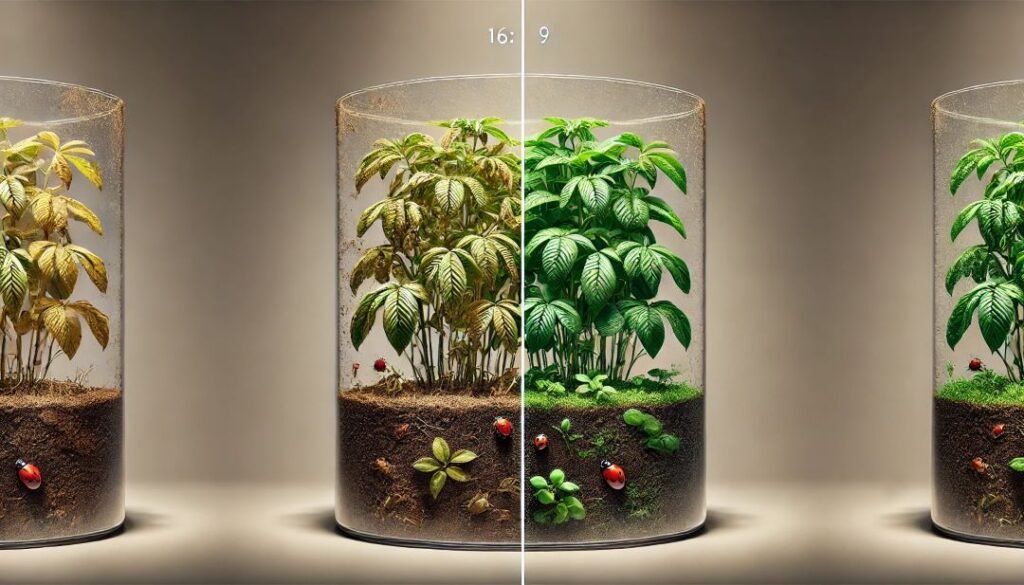Highlights…
- Why Choose Natural Pest Control
- How Natural Pest Control Works
- Top Eco-friendly Pest Management Tips
- Common Pest and Their Natural solution
Homeowners and farmers who use chemical pesticides to control pests are now facing three major problems including environmental degradation, health risks and pesticide-resistant pest populations. Natural pest control creates an environmental solution which operates within the framework of natural systems. This guide contains detailed natural pest management methods supported by scientific evidence accompanied by practical guidance and necessary data for informed choices.
Why Choose Natural Pest Control?
The short-term effectiveness of chemical pesticides produces severe concerns about their long-term effects. The World Health Organization (WHO) reports pesticide poisoning as a yearly occurrence that results in 3 million casualties and 220,000 fatalities. The Environmental Protection Agency (EPA) confirms that pesticides lead to soil contamination which extends to both air and water contaminations thereby endangering bees and birds along with aquatic creatures.
Benefits of Natural Pest Control:
- Safety: The solution provides protection because it does not present any danger to humans or pets in addition to beneficial organisms.
- Environmental Protection: Reduces chemical runoff and pollution.
- Cost-Effectiveness: Often cheaper than chemical alternatives in the long run.
- Sustainability: Promotes biodiversity and ecosystem health.

How Natural Pest Control Works: The Science Behind It
Natural pest control methods are rooted in ecological principles. By understanding pest behavior and life cycles, we can implement strategies that disrupt their growth and reproduction without harming the environment.
1. Biological Control
Biological control involves using natural predators, parasites, or pathogens to manage pest populations. For example:
- Ladybugs consume up to 50 aphids per day, making them a powerful ally against aphid infestations.
- Nematodes (microscopic worms) target soil-dwelling pests like grubs and larvae without harming plants.
2. Cultural Control
Cultural practices modify the environment to make it less favorable for pests. Examples include:
- Crop Rotation: Prevents pests from establishing a permanent habitat. Studies show that rotating crops can reduce pest populations by 30-50%.
- Intercropping: Planting complementary crops together can deter pests. For instance, marigolds release a chemical that repels nematodes.
3. Mechanical Control
Mechanical methods involve physical barriers or traps to prevent pests from reaching plants or entering homes. Examples include:
- Row Covers: Protect plants from insects while allowing sunlight and water to pass through.
- Sticky Traps: Capture flying insects like whiteflies and fungus gnats.
4. Organic Repellents
Natural substances like neem oil, diatomaceous earth, and garlic act as repellents or insecticides. For example:
- Neem Oil: Disrupts the hormonal systems of insects, preventing them from feeding and reproducing.
- Diatomaceous Earth: A powder made from fossilized algae that dehydrates and kills insects on contact.

Top Eco-Friendly Pest Management Tips
Managing pests naturally requires a combination of strategies tailored to your specific environment. Here are some of the most effective eco-friendly pest management tips:
1. Introduce Beneficial Insects
Beneficial insects are nature’s pest control agents. They prey on common garden pests, reducing the need for chemical interventions. Here’s how to attract and use them:
| Beneficial Insect | Pests They Control | How to Attract Them |
|---|---|---|
| Ladybugs | Aphids, mites, scale insects | Plant dill, fennel, and marigolds |
| Lacewings | Aphids, whiteflies, thrips | Grow sunflowers and cosmos |
| Parasitic Wasps | Caterpillars, beetle larvae | Plant yarrow and sweet alyssum |
Pro Tip: You can purchase beneficial insects online or from local garden centers. Release them in the evening when pests are most active.
2. Use Organic Repellents
Organic repellents are safe, effective, and easy to make at home. Here are some popular options:
- Neem Oil: Extracted from the neem tree, this oil disrupts the hormonal systems of insects, preventing them from feeding and reproducing. It’s effective against over 200 species of pests, including aphids, whiteflies, and beetles.
- Diatomaceous Earth: A fine powder made from fossilized algae that dehydrates and kills insects on contact. It’s particularly effective against ants, cockroaches, and fleas.
- Garlic Spray: Blend garlic cloves with water and a few drops of dish soap to create a potent repellent for soft-bodied insects like aphids and spider mites.
3. Practice Crop Rotation
Crop rotation is a time-tested method for preventing pest outbreaks. By changing the types of crops grown in a specific area each season, you can disrupt the life cycles of pests that target particular plants. For example:
- Rotate legumes (e.g., beans) with heavy feeders (e.g., tomatoes) to reduce pest populations by up to 50%.
- Avoid planting the same family of crops (e.g., tomatoes, peppers, and eggplants) in the same spot year after year.
4. Create Physical Barriers
Physical barriers are a simple yet effective way to keep pests away from your plants or home. Examples include:
- Row Covers: Lightweight fabric covers that protect plants from insects and birds while allowing sunlight and water to pass through.
- Copper Tape: Placed around garden beds or pots, copper tape creates a mild electric charge that repels slugs and snails.
- Sticky Traps: Brightly colored traps coated with a non-toxic adhesive to capture flying insects like whiteflies and fungus gnats.
5. Encourage Biodiversity
A diverse garden is more resilient to pest outbreaks. By planting a variety of species, you can attract beneficial insects and create a balanced ecosystem. For example:
- Plant flowers like marigolds, sunflowers, and cosmos to attract pollinators and predators.
- Mix herbs like basil, mint, and rosemary with vegetables to repel pests naturally.
6. Maintain Healthy Soil
Healthy soil is the foundation of a pest-resistant garden. Practices like composting, mulching, and avoiding synthetic fertilizers can improve soil health and reduce pest problems. According to the Rodale Institute, organic farming practices can reduce pest populations by up to 50% while enhancing plant growth.
7. DIY Natural Pest Control Recipes
Garlic and Chili Spray
- Blend 10 garlic cloves and 5 chili peppers with 1 liter of water.
- Strain the mixture and add a few drops of dish soap.
- Spray on plants to repel aphids, beetles, and caterpillars.
Vinegar Solution
- Mix equal parts vinegar and water.
- Use to deter ants, fruit flies, and other small insects.
Common Pests and Their Natural Solutions
| Pest | Natural Solution | Effectiveness |
|---|---|---|
| Aphids | Introduce ladybugs or spray with neem oil. | Reduces aphid populations by 90% |
| Slugs and Snails | Use beer traps or sprinkle diatomaceous earth. | Eliminates 80% of slugs/snails |
| Mosquitoes | Remove standing water and plant citronella. | Reduces mosquito populations by 70% |
| Rodents | Use peppermint oil or humane traps. | Repels rodents effectively |
The Role of Healthy Soil in Pest Control
Healthy soil is the foundation of a pest-resistant garden. According to the Rodale Institute, organic farming practices improve soil health and reduce pest problems by up to 50%. Key practices include:
- Composting: Adds nutrients and beneficial microorganisms to the soil.
- Mulching: Retains moisture and suppresses weed growth.
- Avoiding Synthetic Fertilizers: Prevents soil degradation and pest outbreaks.
Frequently Asked Questions (FAQs)
Q: Are natural pest control methods as effective as chemical pesticides?
A: While natural methods may take longer to show results, they are equally effective in the long run and safer for the environment. For example, neem oil can reduce pest populations by 70-90% within a few weeks.
Q: Can I use natural pest control indoors?
A: Yes! Methods like diatomaceous earth, essential oils, and traps work well for indoor pest control. For instance, peppermint oil repels ants and spiders with 90% effectiveness.
Q: How often should I apply organic repellents?
A: Reapply every 7-10 days or after heavy rain for best results.
Conclusion
Natural pest control provides a sustainable and environment-friendly method of pest management which does not harm your well-being or the natural world. Applying scientific pest-control strategies combined with practical implementations will lead you to create Gardens which both prosper naturally while remaining free from pests. Initiate small practices followed by experimentation of different methods to experience environmental advantages in your greener life path.
References:
- World Health Organization (WHO). (2023). Pesticide Poisoning. Link
- Environmental Protection Agency (EPA). (2023). Pesticides and the Environment. Link
- Rodale Institute. (2023). Organic Farming and Soil Health. Link


Pingback: Companion Planting in Vegetable Farming: Boost Yields, Deter Pests, and Enhance Soil Health Naturally - Agro Reality